1lumen selects and reviews products personally. We may earn affiliate commissions through our links, which help support our testing.
Lumintop PK25 review
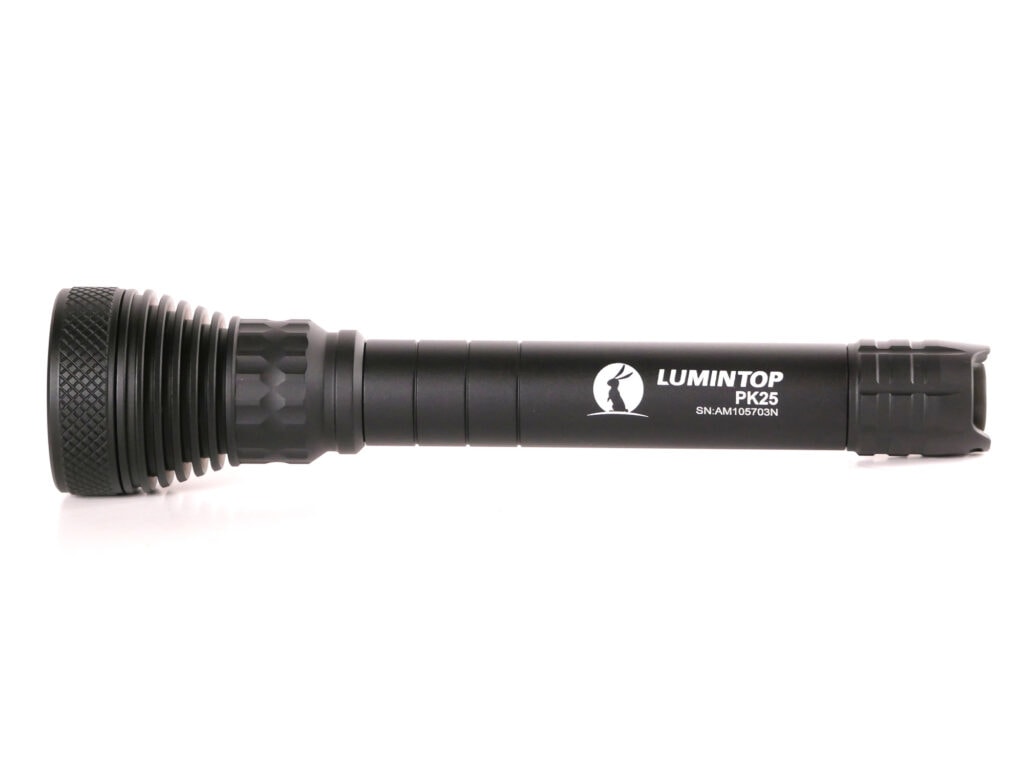
Lumintop PK25 specs
| Brand & Model | Lumintop PK25 |
|---|---|
| Flashlight category | EDC / Long-Range |
| LED | OSRAM NM1 |
| Max. output | 350 lumens |
| Max. beam distance | 490 meters |
| Max. beam intensity | 60100 cd |
| Battery config. | 2* AA (No 14500) |
| Onboard charging | No |
| Modes | 4 |
| Blinkies | Strobe |
| Waterproof | IP68 |
| Review publication date | March 2023 |
Review intro:
When given the opportunity to review the Lumintop PK25, the first thoughts in my head were, ‘I wonder how this compares to a AA Maglite Mini that I used to have’. Secondly, this is a departure for me in what I have come to know from Lumintop. Well, use at least. I have used a Thor 3 LEP and an FW1AA and this is nothing like either of those. Throwers yes, but a completely different form factor. Now Lumintop is no stranger to small throwers, as they have released the Ant Man, GT Nano Pro and their entire lineup of Thor LEPs, this is another in their arsenal that can throw the distance as well as keep a small profile if the claims are to be believed. Let’s find out if the PK25 has what it takes to walk the walk with the other Lumintop throwers or if it is relegated to a wannabe. So, let’s insert some batteries (not included) and fire this puppy up!
Package quality.
The packaging, while more than sufficient, is quite sparse. The light is not inherently heavy so it does not need an exorbitant amount of padding or protection. Lumintop does well in this category and it reminds me of all of my other Lumintop lights. A very thick cardboard box with a microcell foam insert that keeps the PK25 firmly secured. No extras needed here. All in, the entire contents were made up of:
- Lumintop PK25
- 2* Spare O-Rings
- Manual
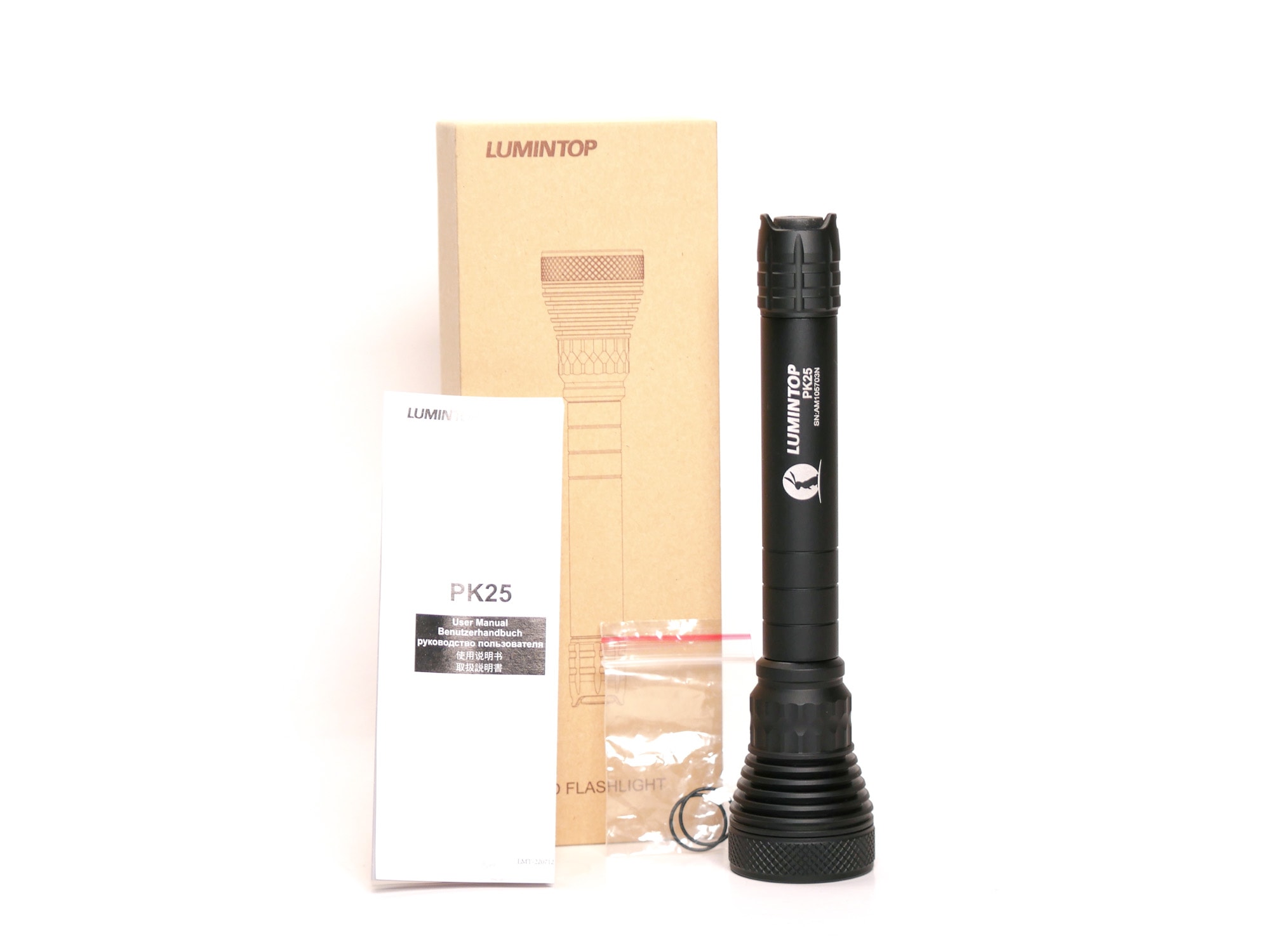
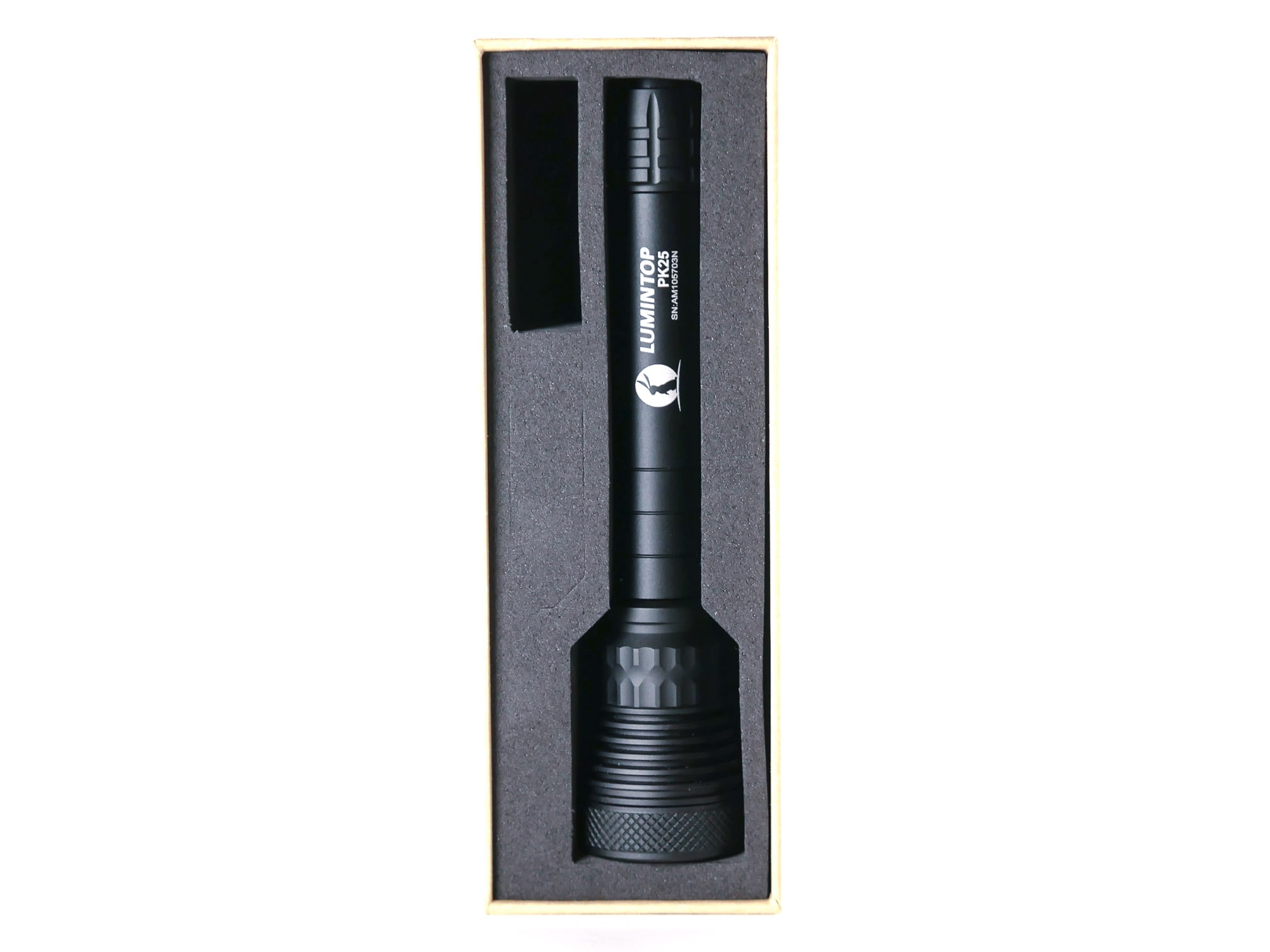
Flashlight in use
The PK25, after picking it up out of the box, makes me think differently than my initial assessment of comparing it to the Maglite Mini. This feels completely different. Instead of the shiny metal, you have a very matte black anodizing that seems to give it less friction and as a result a more slippery feel, at least in my opinion. There is quite a bit of machine work, but the body is completely void of all of it. The head is much larger than the rest of the body and it does fit in a pocket, but the business end is quite noticeable.
With a reverse clicky switch on the tail cap, you can change modes after it is already on. This clicky switch also includes the Lumintop logo, with the bunny in all of its glory. I wouldn’t say it adds too much to the grip of it, but it is a nice touch. It also sits recessed under two ridges that are saddle cut in the tailcap that give you a lanyard attachment point, but also allow it to tail stand. The saddles aren’t the widest though (there isn’t a lot of space on an AA light) so it may seem a little unstable while tail-standing. Unfortunately there is no pocket clip, or even a provision for one.
This is a relatively long range general purpose throw light, so it could be used for quite a few things. If you need throw over flood, this may be a good choice. It is lightweight and could be carried without it weighing you down. The first thing I thought of is if you are looking for a lost animal and want to cover a longer distance without the need to carry a huge LEP or purpose built, dedicated search light.
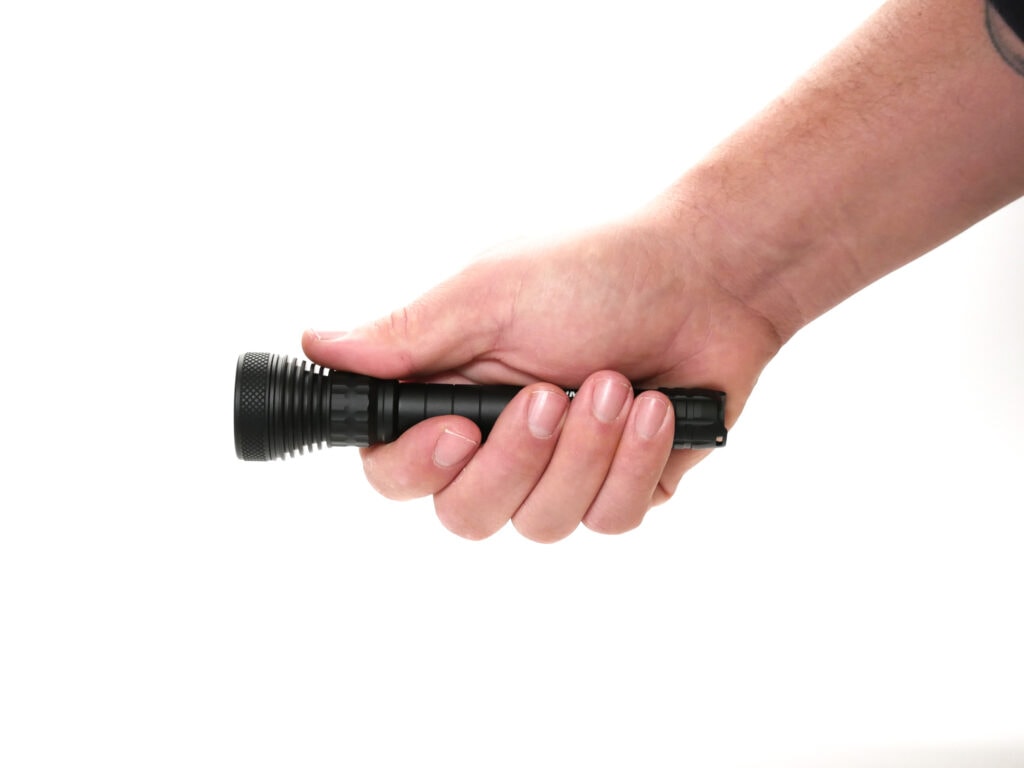
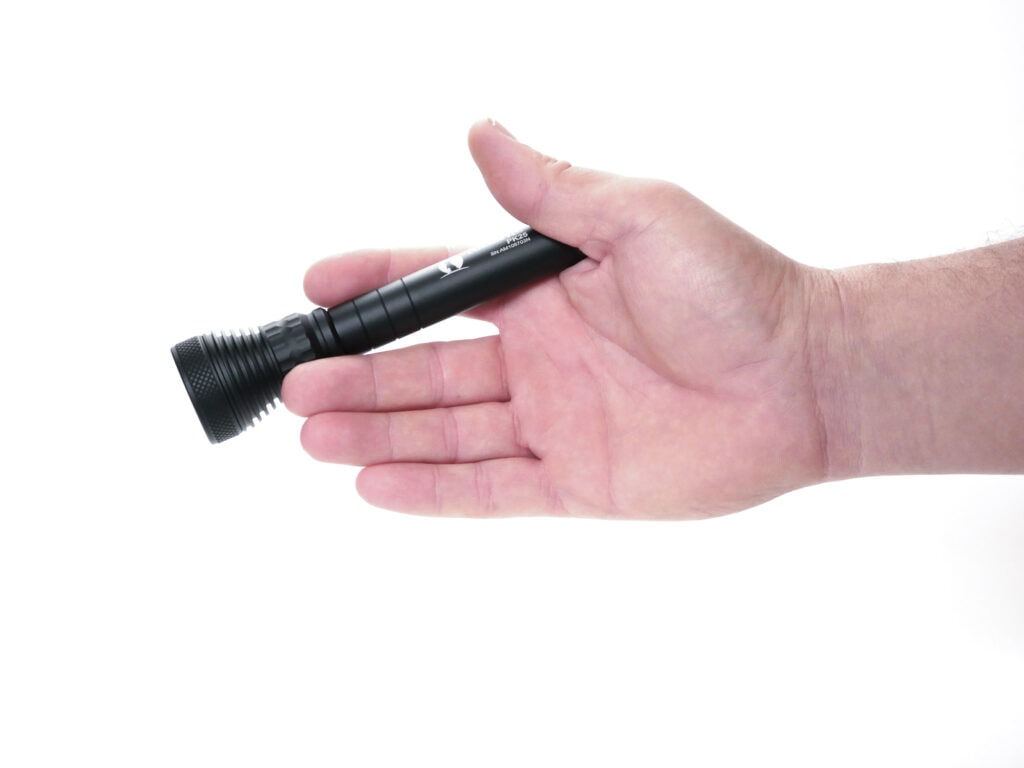
Build Quality and Warranty
Every Lumintop I have owned or even used has been of amazing quality and finish. The PK25 on the other hand… Nah, I am just kidding. The details in the machining and evenness of the Type III HA coating over the 6061- AL body. This anodization is a smooth, even and matte black. From what I could tell, no other colors were available.
The only eyesore, and I hate to say this, is the Lumintop logo and identifying info on the battery tube. It takes up over 20% of the entire length of the light (I measured) and should have been toned down a bit. The tailcap looks like it may have been pulled from a tactical light and I rather like it, and if it would have contained a forward clicky switch, I may have just believed it was a parts bin pull.
The switch does have the common Lumintop rabbit on the button, but does not light up like some of their other models. When you remove either the tail or the head to swap in some batteries, you’ll see the threads have an absolute abundance of lubrication. The body of the light looked greasy very quickly. Over cautious, or did it slip by quality control? Either way, I don’t fear a short life for these o-rings due to being run dry.
As far as the warranty is concerned, this is from Lumintop.com:
30-day free replacement: LUMINTOP will replace a new product within 30 days of purchase for any manufacturing defects if problems come into being in normal use; We will replace it with the same model. If the model has been discontinued, customers will receive a product with a similar or improved model. Five-years free repairs: LUMINTOP will offer free repair within 60 months for lights from the date of purchase if the problem develops with normal use. Lifetime warranty: If repair is required after the guarantee period, we’ll charge for parts accordingly. All LUMINTOP products are warranted for quality. Normal wear and tear are not covered, nor is damage resulting from misuse, abuse, neglect, battery damage, use of incorrect batteries or accessories, or altering these products from their original state. Parts and accessories for flashlights are not covered by this warranty.
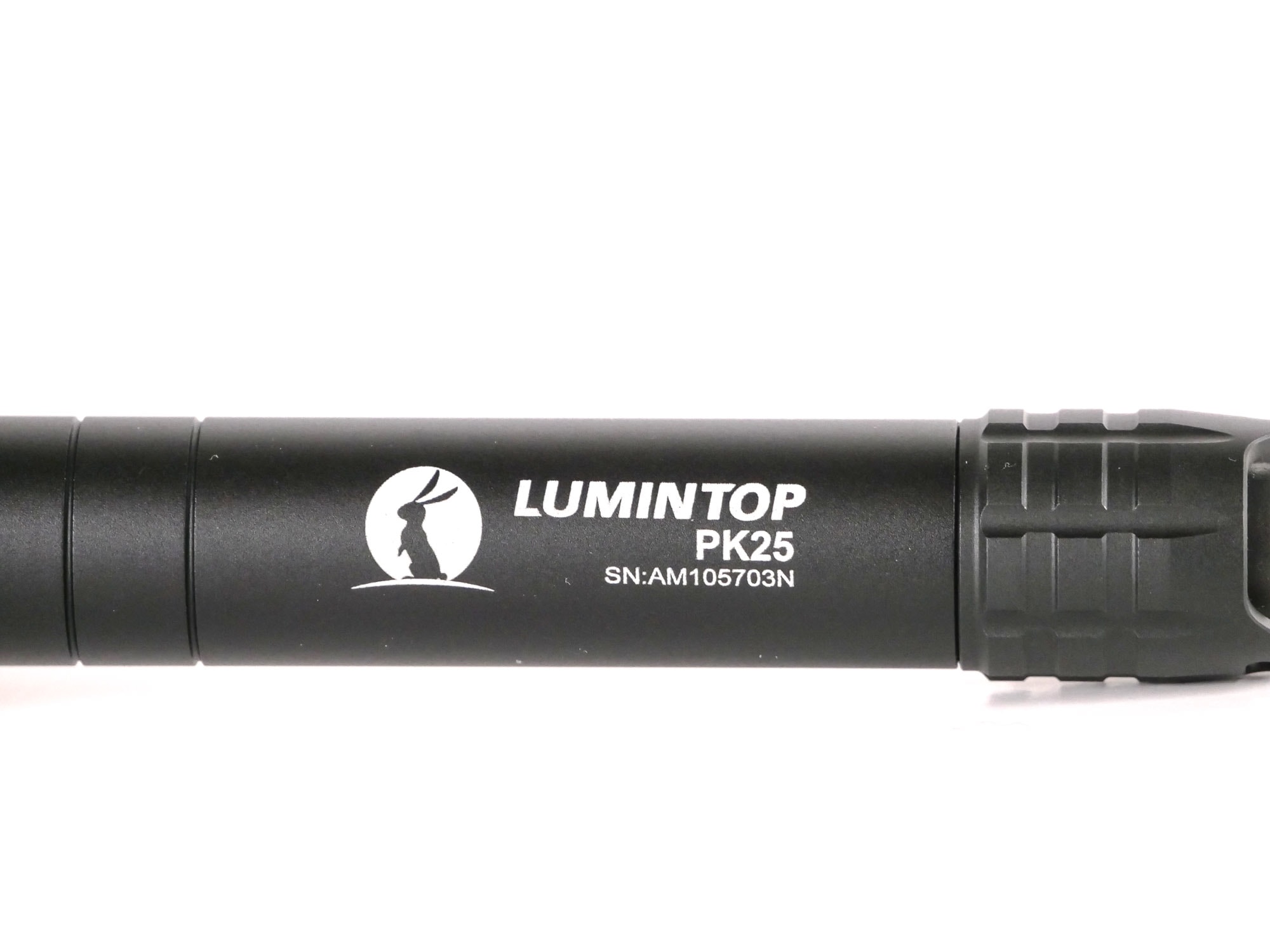
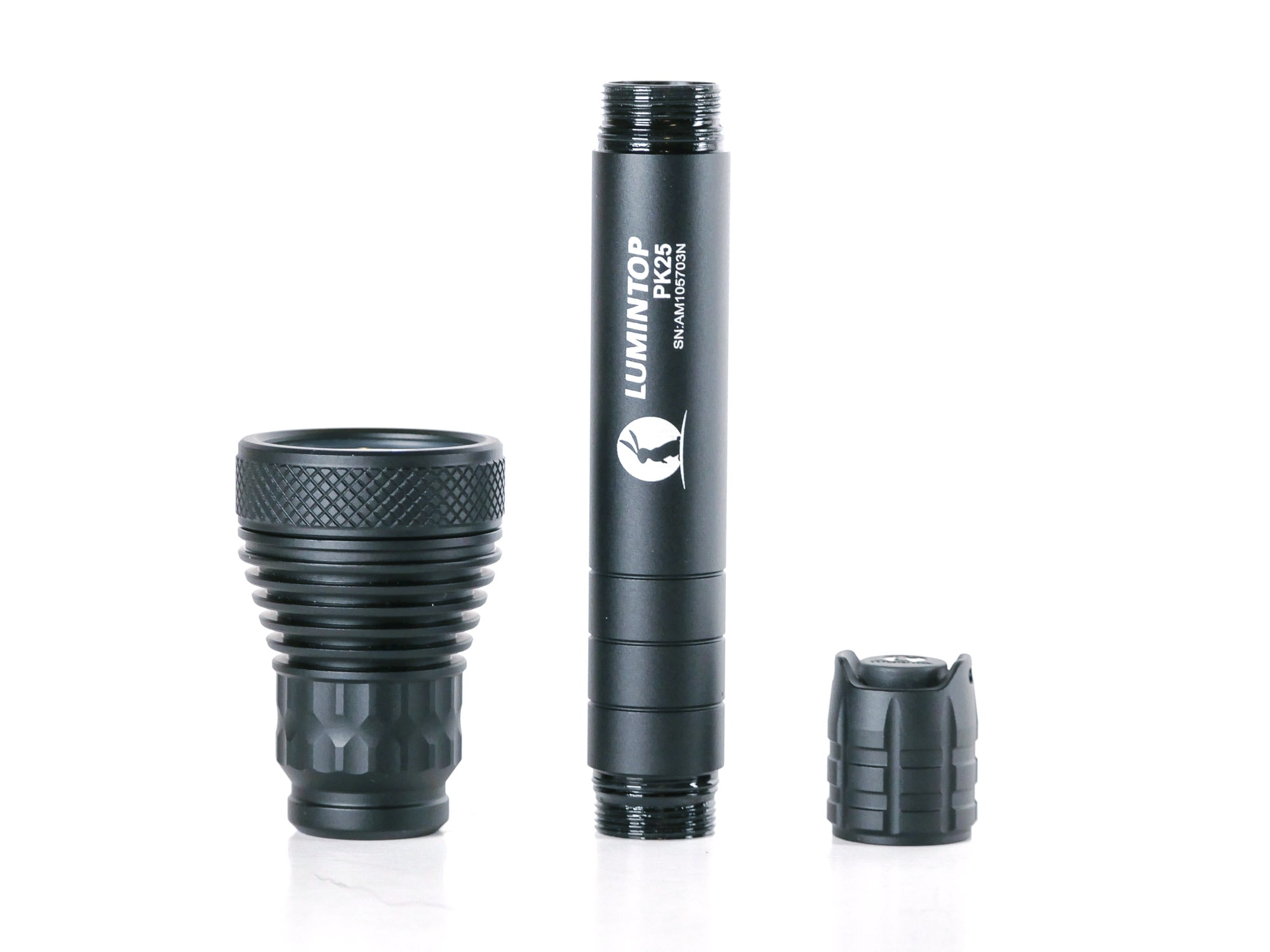
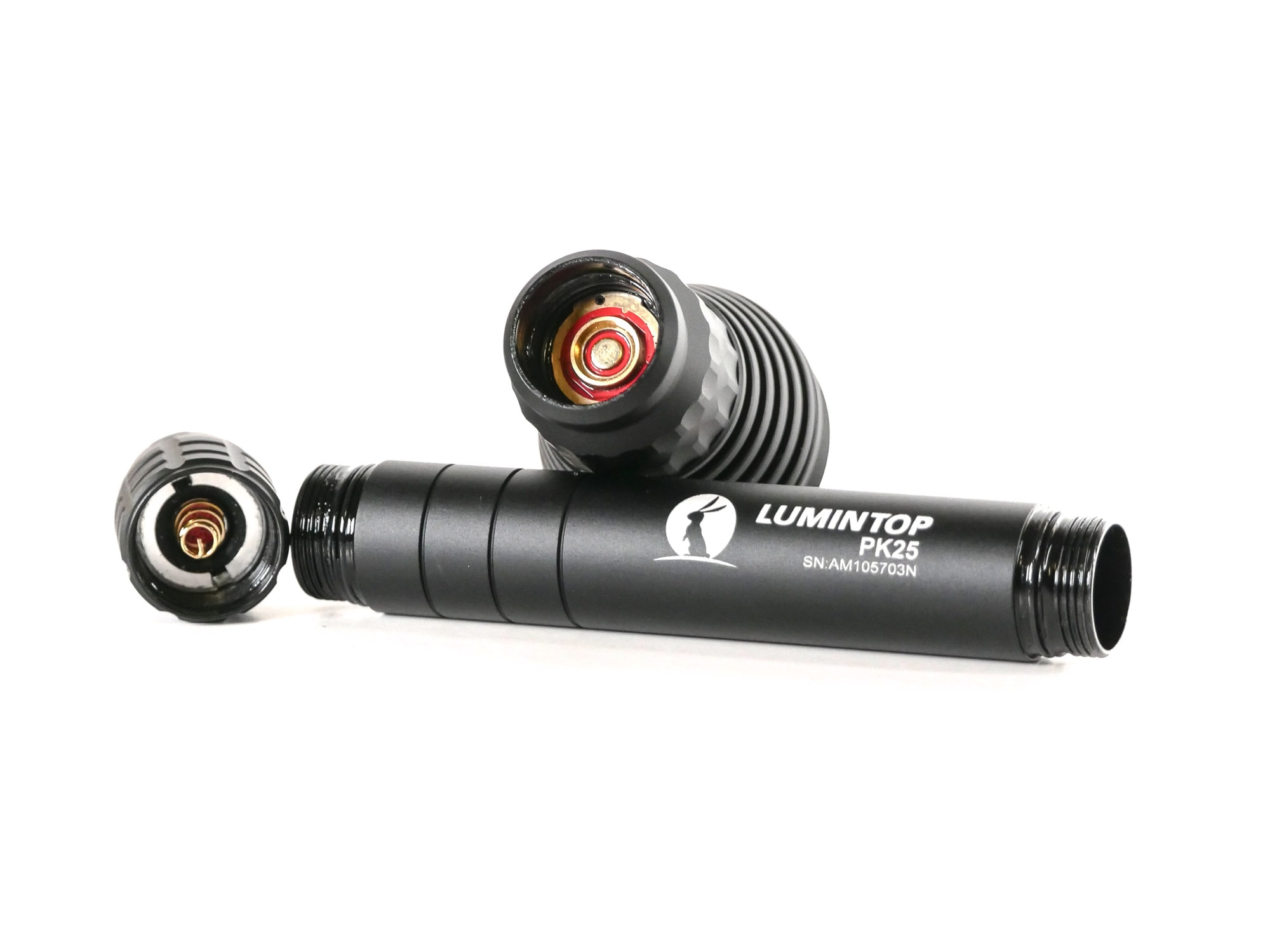
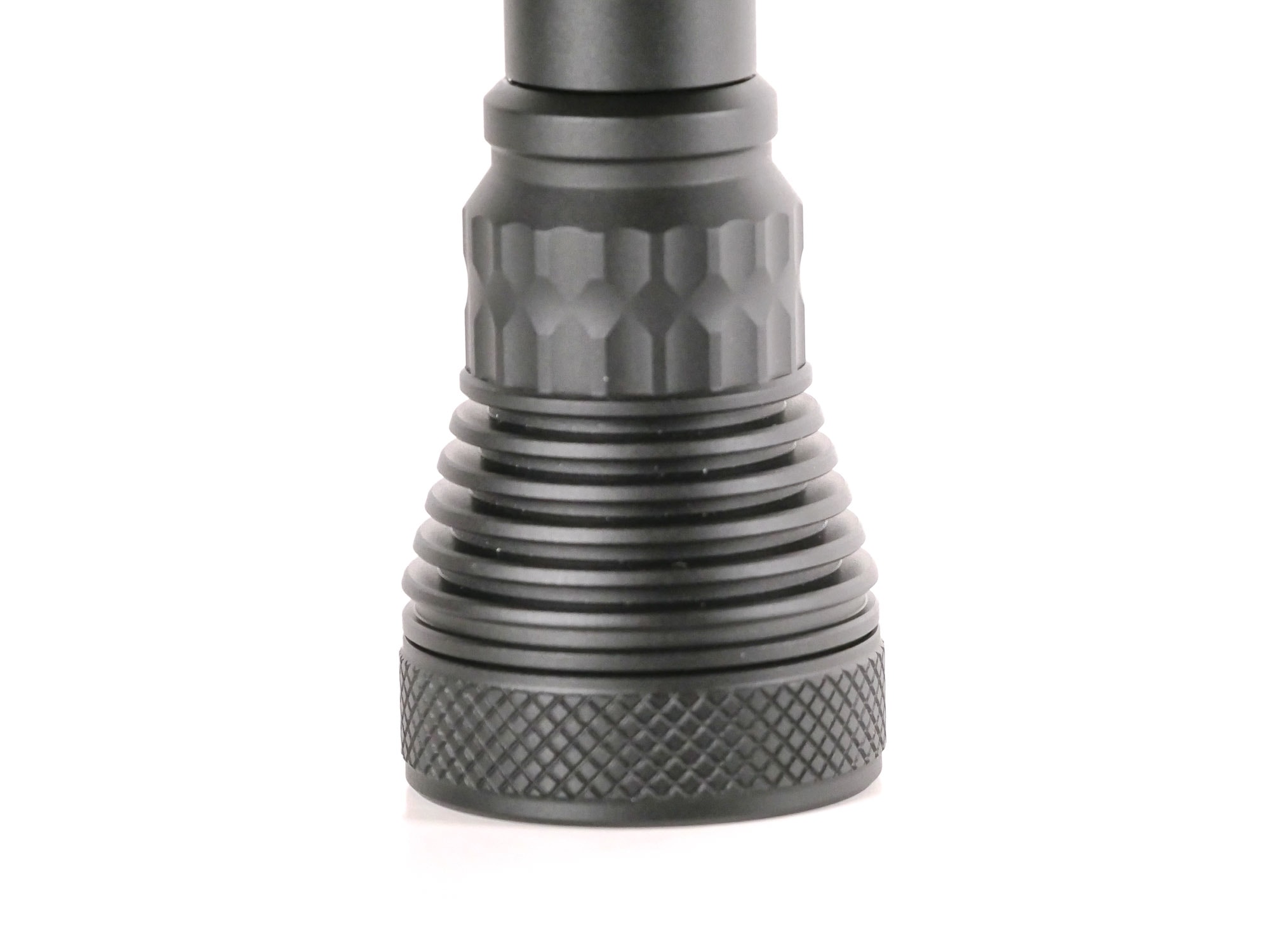
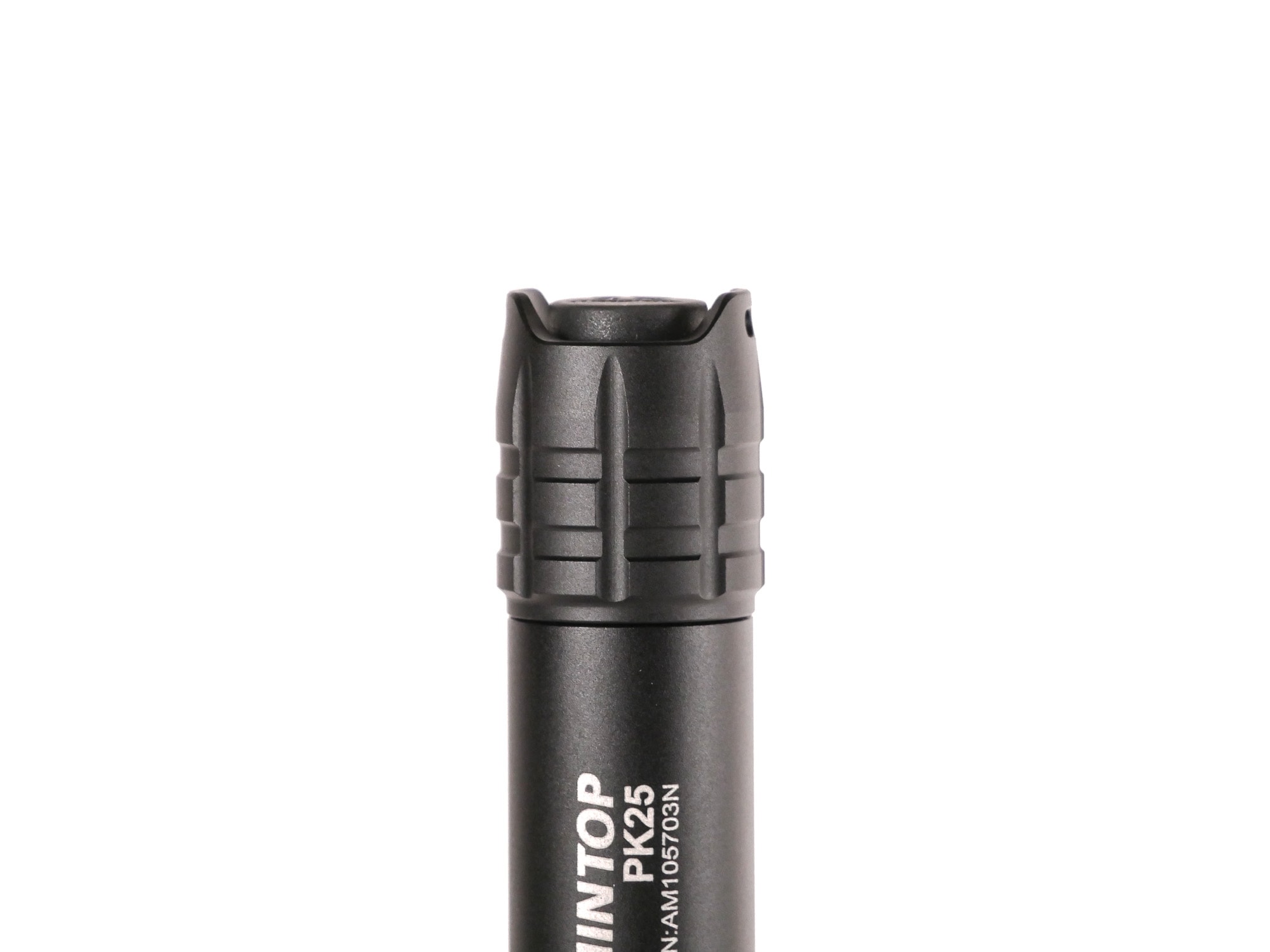
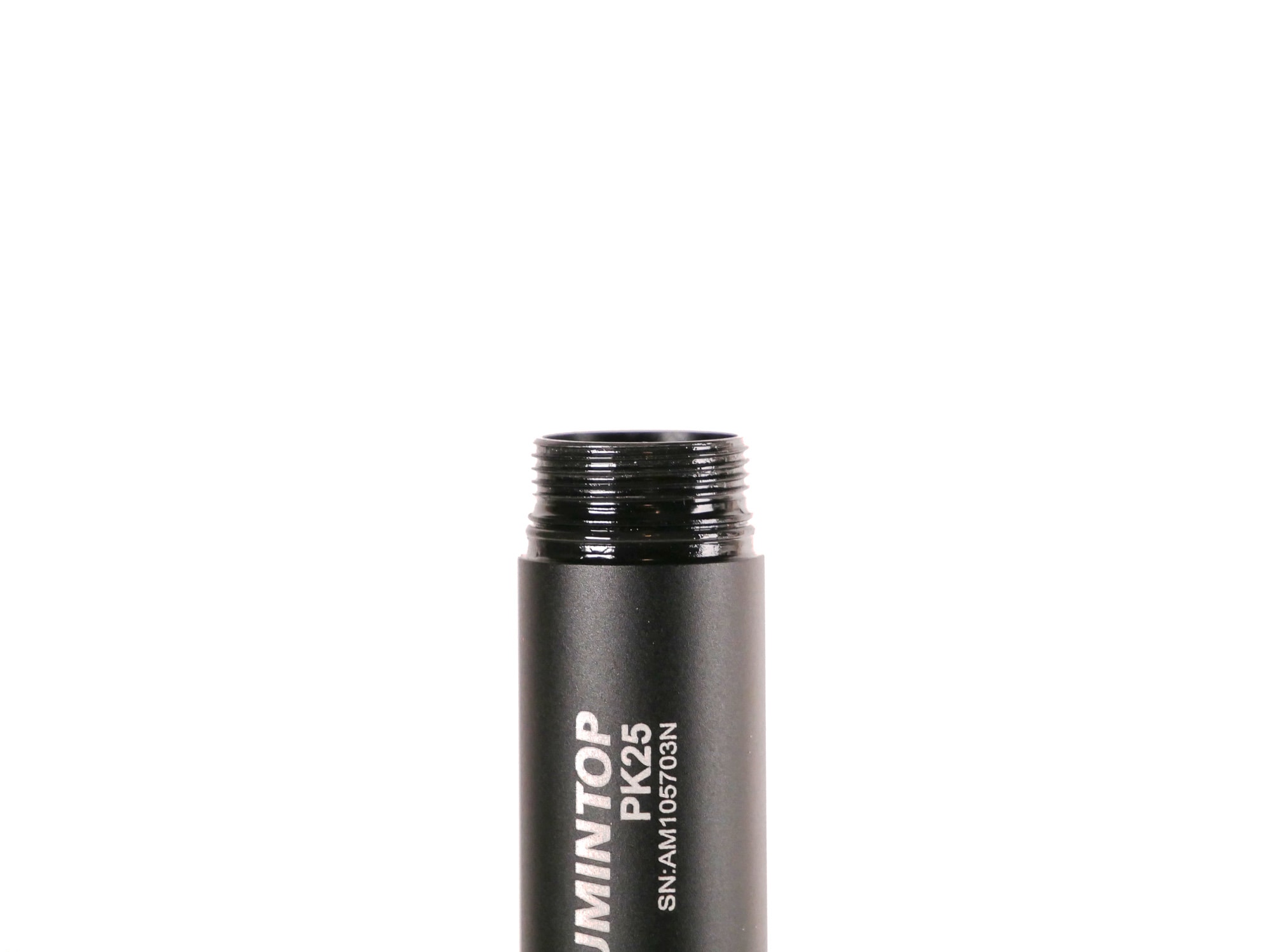
LED, Lens, Bezel, Beam, and Reflector
The head of the Lumintop PK25 kind of reminds me of the Tardis from Doctor Who. It is bigger on the inside. For such a small profiled light, this has an immensely deep reflector. The smooth reflector is 30mm in length and sits beneath an AR coated glass lens. The emitter, in this case an OSRAM NM1 LED, is perfectly positioned at the bottom with a black centering gasket.
The combination of both the reflector and the LED gives you an incredibly focused hotspot and with a usable amount of spill. The cutoff on that spill, though, is exact. Someone got their medical degree and became a surgeon to cut this so exact. There is a spill and then it seems one mm aside there is no light at all.
It is like a widebeam LEP, but seems even more pronounced. The hotspot makes sense, considering you are supposed to get almost 500 meters of throw from 350 lumens. Close up, you’ll also see a corona around that hotspot but it is much less noticeable at a distance. This whole combination is ideal for throw, so if you’re looking for a floodlight, this definitely isn’t it.
What this isn’t ideal for, is color-accurate tint. Now, this isn’t a negative, since most throwy lights will appear on the cooler side anyway as this does. Using the Opple Lightmaster Pro at 5 meters, the PK25 in low starts out around 5700k and jumps up to over 6100k in turbo. And usually with these OSRAM emitters, that color rendering is on the lower side too. This light follows suit at between 70 and 72 CRI. Not wonderful, but at a distance, this is more than sufficient.
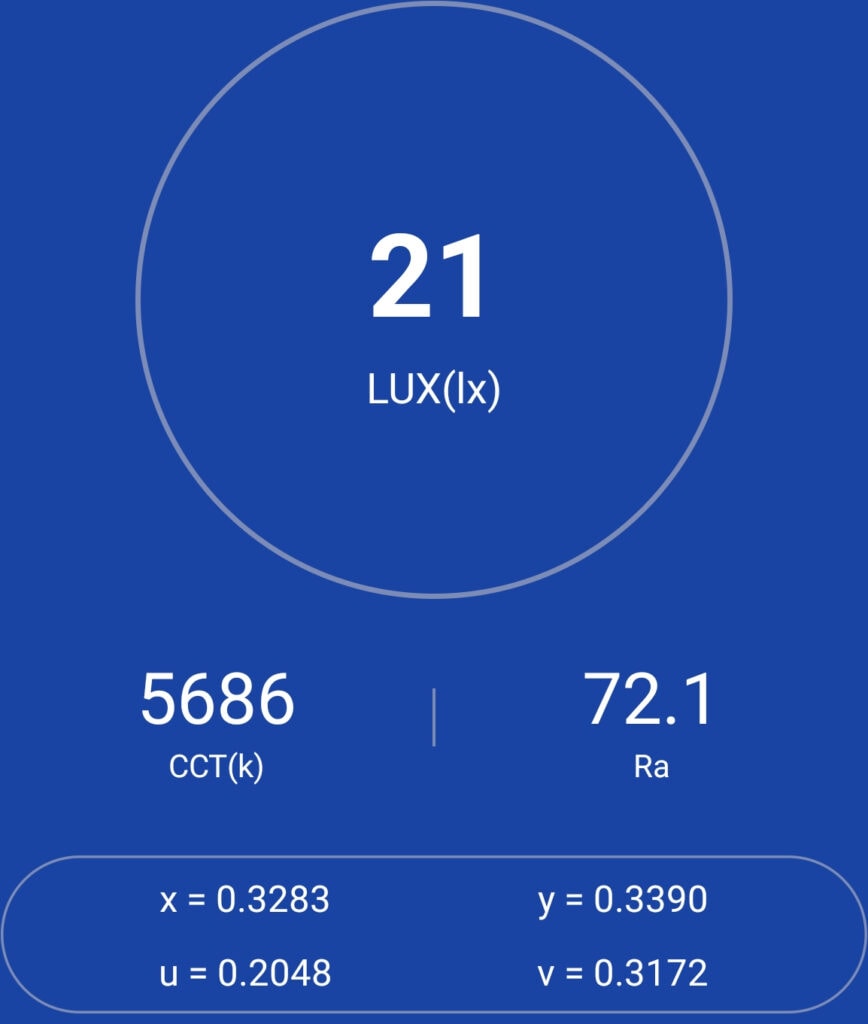
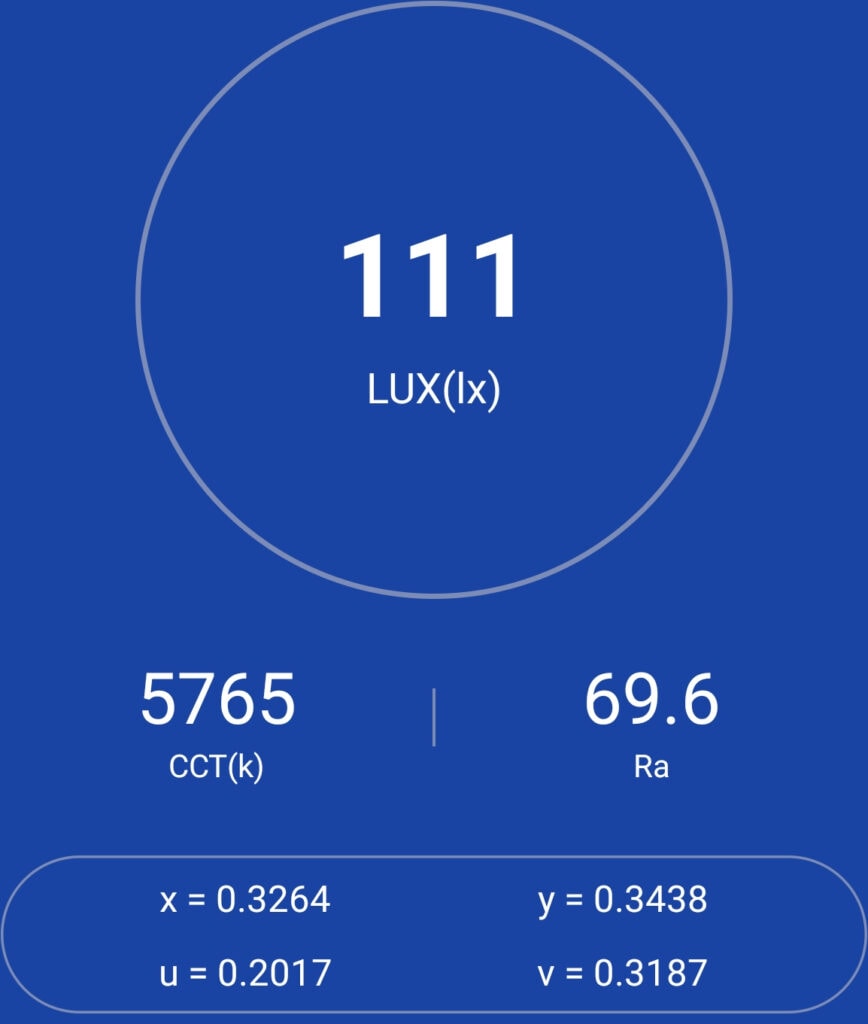
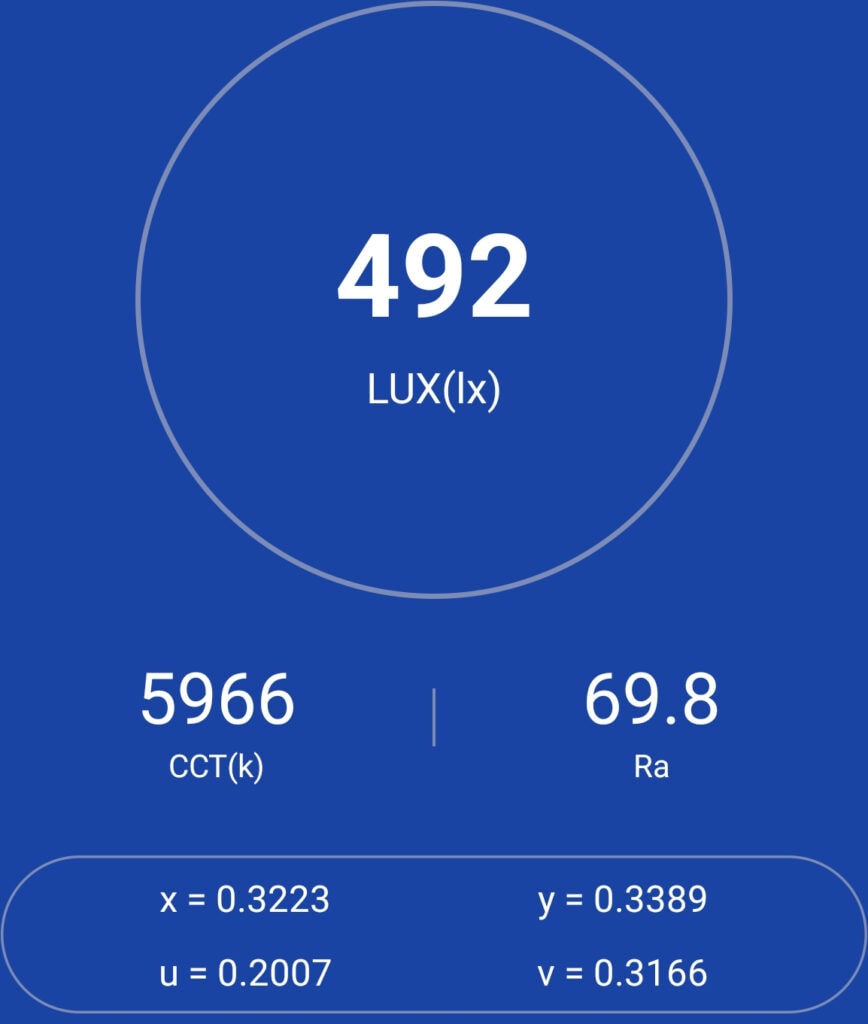
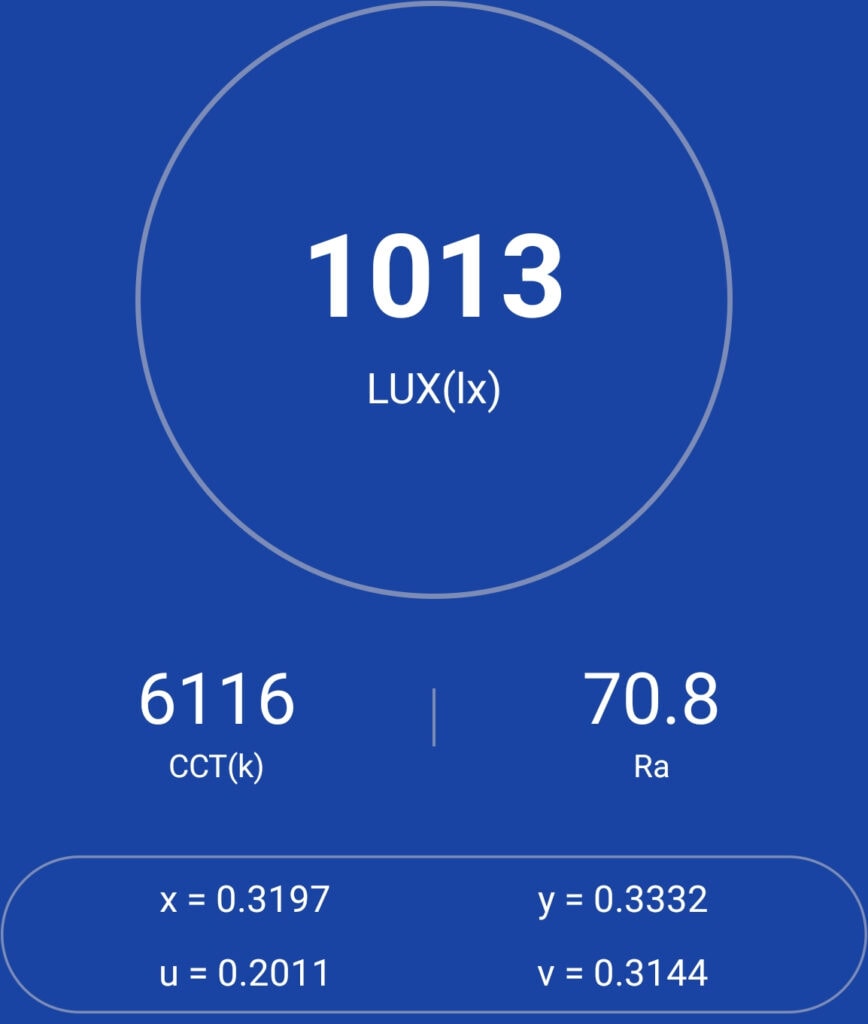
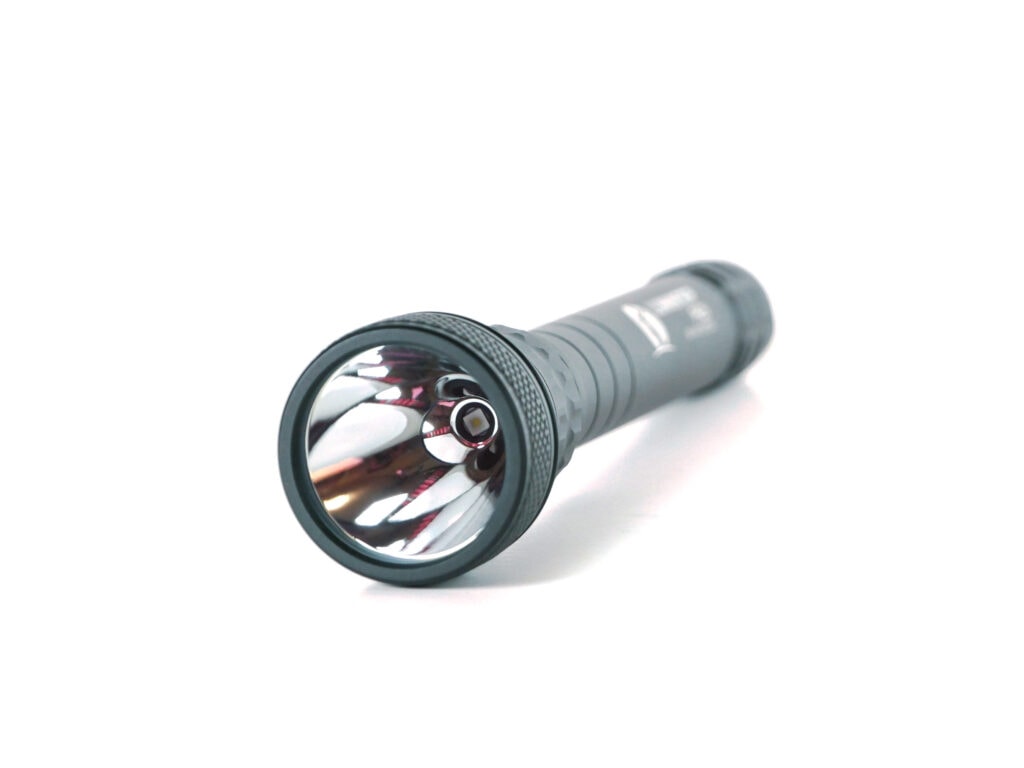
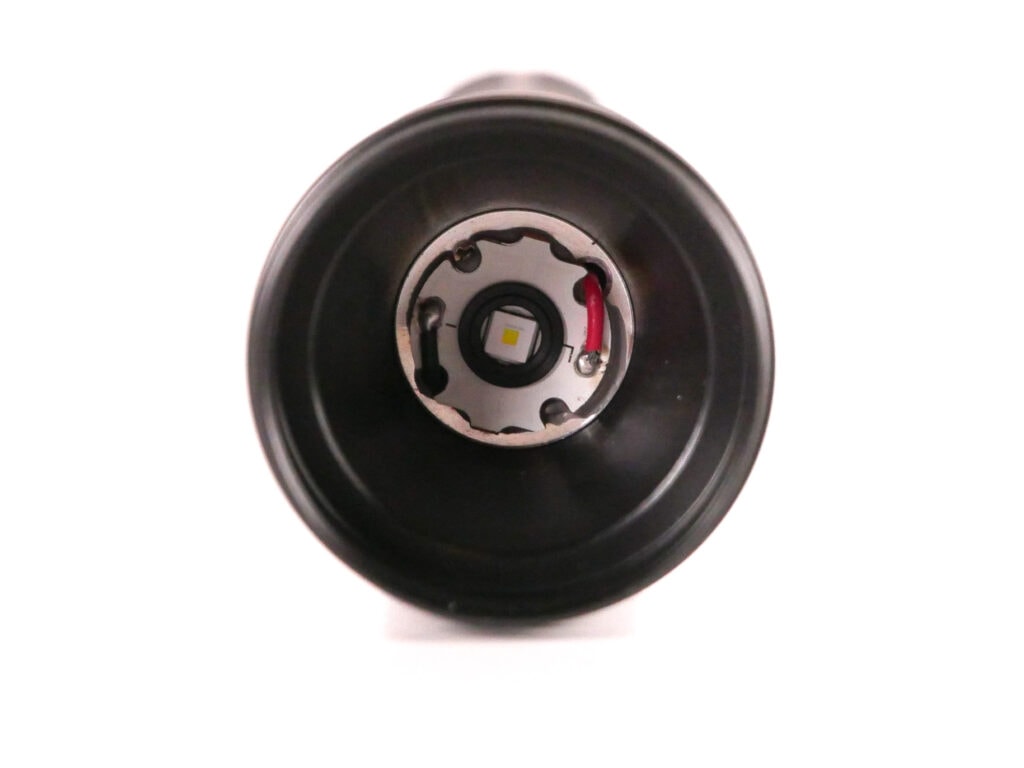
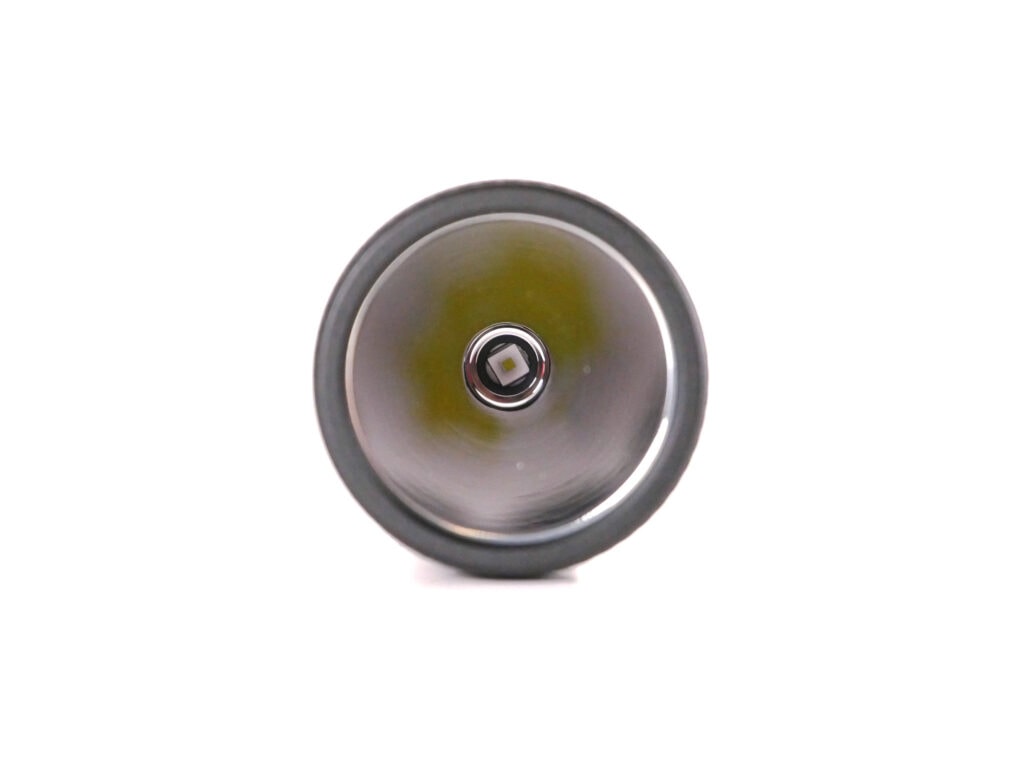
Dimensions and its competition
Dimensions:
| Lumintop PK25 | Millimeters | Inches |
|---|---|---|
| Length | 162 mm | 6.4 in |
| Head diameter | 37 mm | 1.5 in |
| Body diameter | 19 mm | .7 in |
Dimensions are rounded to the nearest millimeter, and to the nearest tenth of an Inch.
Weight:
| Lumintop PK25 | Weight in grams | Weight in oz |
|---|---|---|
| Without battery: | 83 g | 2.9 oz |
| With battery | 121 g | 4.3 oz |
Weight is rounded to the nearest gram, and to the nearest tenth of an Oz.
Flashlight size comparison with its competition:
Group 1: Lumintop PK25, Convoy T4, Olight i3T Plus, Wurkkos WK02
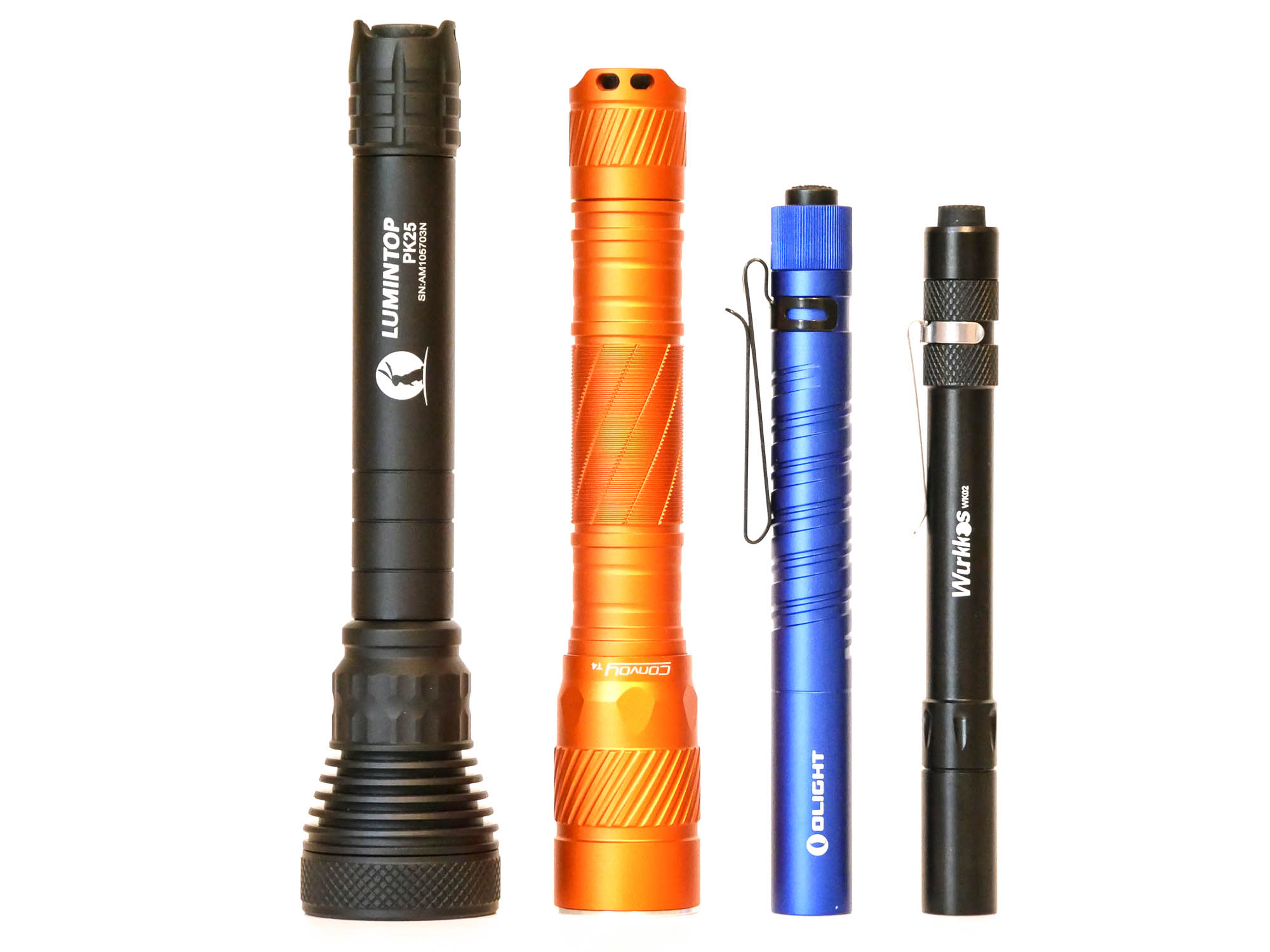
Lumintop PK25 UI: User Interface and Driver
There are no batteries shipped with this light so there is no lockout or insulating film to stop you from turning on the PK25. All you have to do is load up some fresh AA batteries (Alkaline or NI-MH) and follow the instructions below to navigate the UI on this particular Lumintop offering.
Available modes:
- Low, Medium, High, Turbo
Available blinky modes:
- Strobe
From OFF:
- Single Click: Turn on the PK25
From ON:
- 1 Click: Turn off the PK25
- 1 Tap: Change modes (Low, Medium, High, then Turbo)
- 6 Taps: Activate Strobe
Mode memory:
- Yes, the light will go into the previous used mode you were in, with the exception of Strobe.
Shortcuts:
- N/A
Low voltage warning:
- The battery continues to decrease in output, but there is no battery indicator or flash sequence to let you know the battery is depleted.
Strobe/blinkies
- Tap tail cap 6 times from on
Lock-out mode:
- No, but you can do a quarter-turn lockout with the tail cap since the threads are anodized.
PWM
- There is no PWM present.
Additional/summary info on the UI:
- Unfortunately, there is no voltage check or battery check, but with the availability of AA batteries, I suppose it isn’t necessarily needed. All in all, the UI is very straightforward if you have used a reverse clicky before. The sweep of the modes seems evenly spaced for the light.
Lumintop PK25 Charging and batteries
There is no onboard charging provided on the PK25, and as a matter of fact, there are no batteries at all. This trim did not ship with any batteries, but what it does accept is either 2* AA Alkaline cells with an operating voltage of 1.5V or 2*AA NI-MH cells running at 1.2V. Lumintop specifically says to not use 14500 Li-Ion cells as this would result in damage to the board and I believe them. Jumping from 3 volts to (up to) 8.4 volts could fry the driver in a second.
Performance test
For my output measurements, I utilized a purpose built integrating sphere and an ExTech SDL400 datalogging light meter. These figures were compared to a tested, known light source. All tests were performed with both fresh alkaline and fully charged NI-MH batteries after a complete charge cycle. The exact batteries used in this case are Rayovac High Energy for the alkalines and Amazon Basics NI-MH for the rechargeables.
Lumen measurements (for each mode)
| Mode (Alkaline) | Specs | @turn on | 30 sec | 10 minutes |
|---|---|---|---|---|
| Low | 6.5lm | 6lm | 6lm | 6lm |
| Med | 45lm | 34lm | 34lm | 34lm |
| High | 175lm | 151lm | 151lm | 151lm |
| Turbo | 350lm | 313lm | 310lm | 149lm |
| Mode (NI-MH) | Spec | @turn on | @30 sec | @10 minutes |
|---|---|---|---|---|
| Low | 6.5lm | 6lm | 6lm | 6lm |
| Medium | 45lm | 35lm | 35lm | 34lm |
| High | 175lm | 149lm | 149lm | 148lm |
| Turbo | 350lm | 319lm | 316lm | 151lm |
The low mode output was relatively consistent with specifications, however, when you move higher up in the range, you can see there is between a 20 and 10 percent drop in performance compared to their specifications, with the gap closing slightly towards the top end. In turbo, the figures came out to be right at 10 percent low, which could fall on the batteries or a slight variance in my testing equipment.
Battery Life: Runtime graphs
I ran through low, medium, high and Turbo with both Rayovac Alkaline AA and completely charged Amazon Basic Rechargeable Ni-MH batteries and performed all tests until the light shut off.
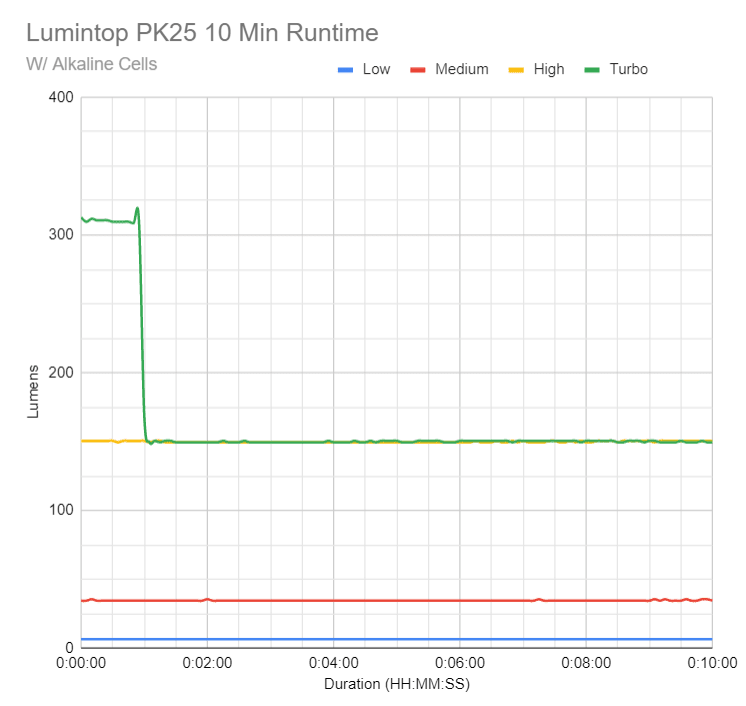
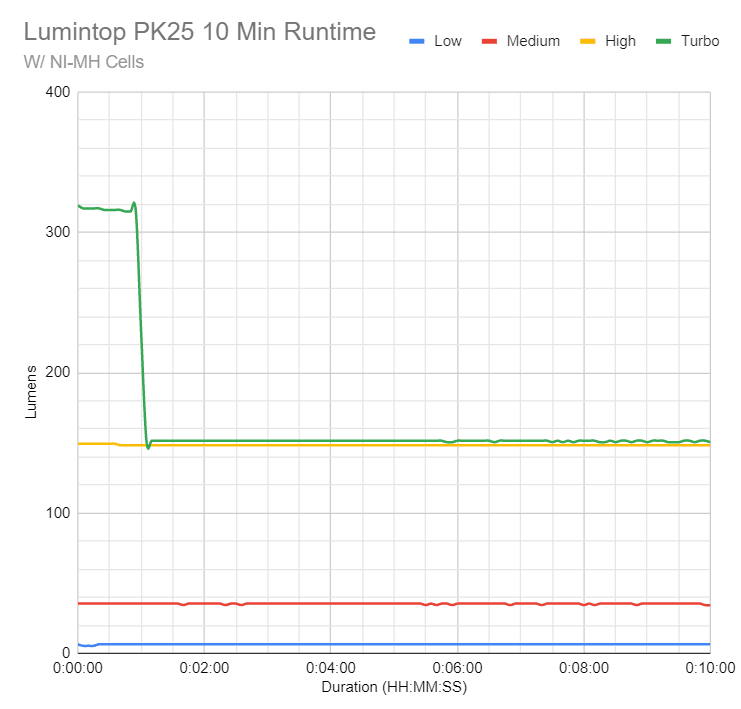

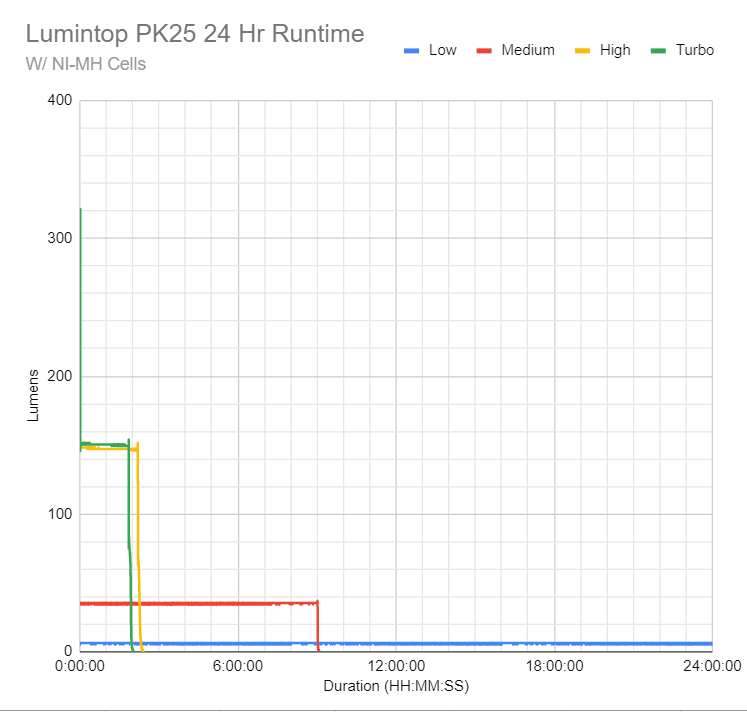
| Mode (Alkaline) | Specified runtime | Measured runtime ANSI | Time till shut off |
|---|---|---|---|
| Low | 15h | 24h+ | 24h+ |
| Med | 7h 35min | 8h 28min | 8h 29min |
| High | 1h 10min | 1h 22min | 1h 47min |
| Turbo | 1h 2min | 1h 18min | 1h 37min |
| Mode (NI-MH) | Specified runtime | Measured runtime ANSI | Time till shut off |
| Low | 20h 40min | 24h+ | 24h+ |
| Medium | 9h 15min | 9h 2min | 9h 5min |
| High | 2h 15min | 2h 17min | 2h 25min |
| Turbo | 2h 12min | 1h 56min | 2h 1min |
While the output may have been slightly under specification, the runtimes, at least in most regards outperformed what Lumintop has come to expect of these lights. Now, there are many variables in the types, construction and capacities of batteries that can be used, but these are the results I got. With alkalines, the low runtime bested specs by over 9 hours. I like this, but the manual for the PK25 says nothing about the capacities of the batteries used in testing.
About ANSI FL1 standards: The runtime is measured until the light drops to 10% of its initial output (30 seconds after turning on). This does not mean that the flashlight is not usable anymore. The last column shows how long the light actually works till it shuts off. If there is a + symbol, it means that the test was stopped at that particular point, but the light was actually still running. This happens on certain occasions, with certain drivers, firmware, or batteries.
Peak beam intensity and beam distance measurements
Throw information was gathered using an Opple Lightmaster Pro at 10m after 30 seconds using fresh alkalines and fully charged NI-MH cells.
| Mode | Specs | Candela measured | Meters | Yards |
|---|---|---|---|---|
| Low | * | 1,344 cd | 73 m | 80 yd |
| Medium | * | 7,104 cd | 169 m | 185 yd |
| High | * | 31,488 cd | 355 m | 388 yd |
| Turbo | 60,100cd | 64,832 cd | 509 m | 557 yd |
One thing I have found to be unusual is the hands down win in the throw department, even though the output of the PK25 is on the lower side. I mean, it is quite focused, and as you can see from the beamshots the hotspot is still quite bright.
About peak beam intensity: Peak beam distance according to ANSI FL1 standards: The calculated value of distance in meters at which the flashlight produces a light intensity of 0.25 lux. (0.25 lux is about the brightness of a full moon shining on an object). The columns ‘Meters’ and ‘Yards’ use rounded numbers.
Beamshots
Camera settings and distance: Panasonic Lumix G7 with ISO 5000 and ev0.0 at 70y.
Beamshots of the following flashlights compared:
- Lumintop PK25
- Wurkkos FC12
- Convoy S21B
The following beamshots are done with NiMH batteries. Alkaline batteries
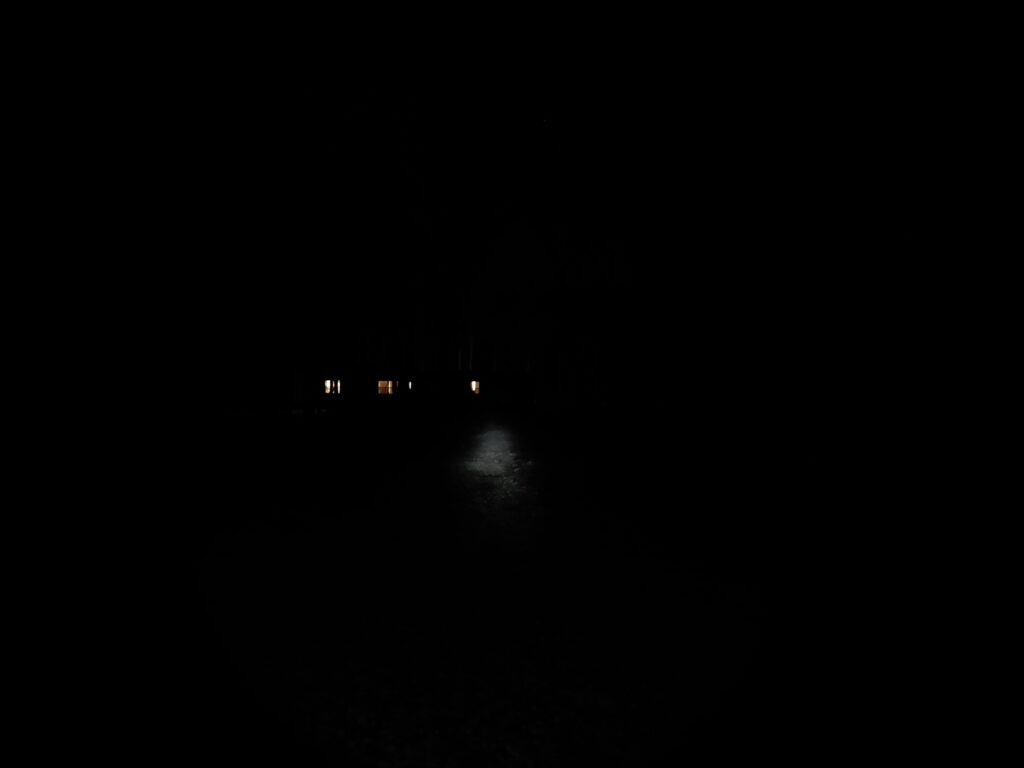
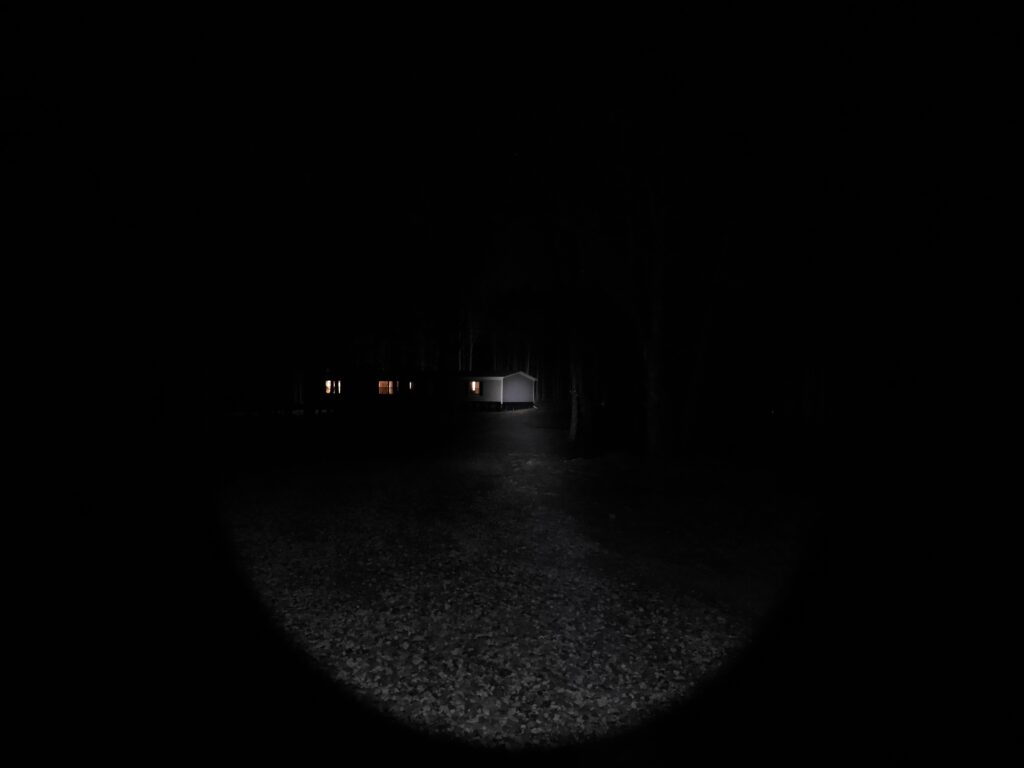
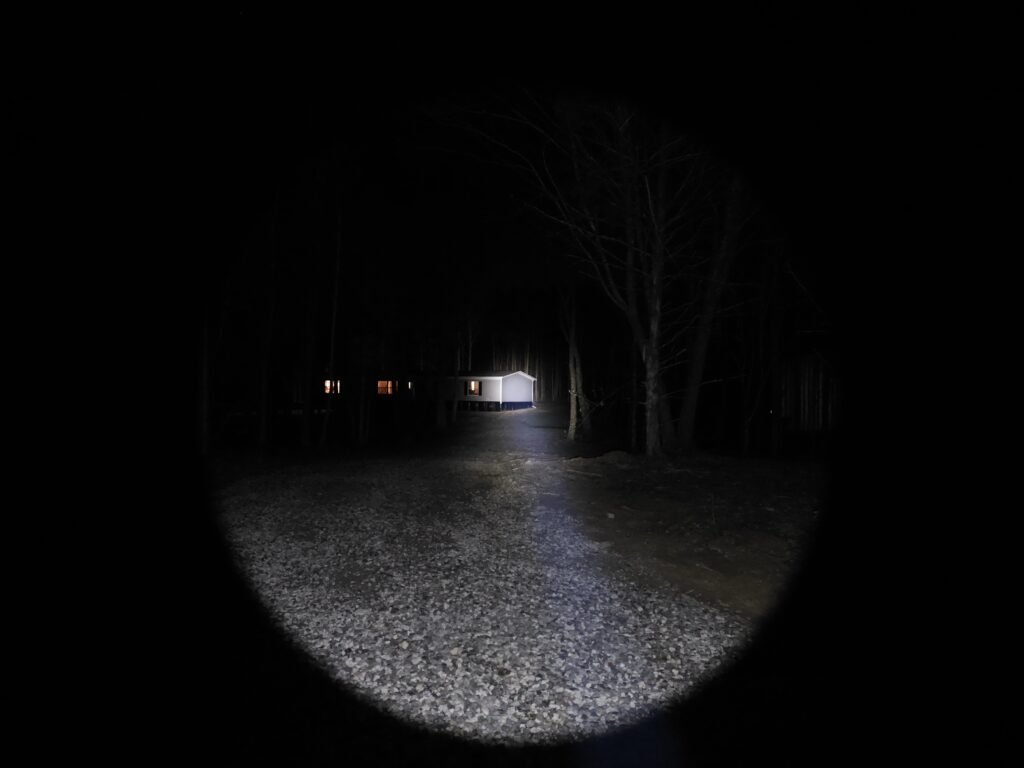
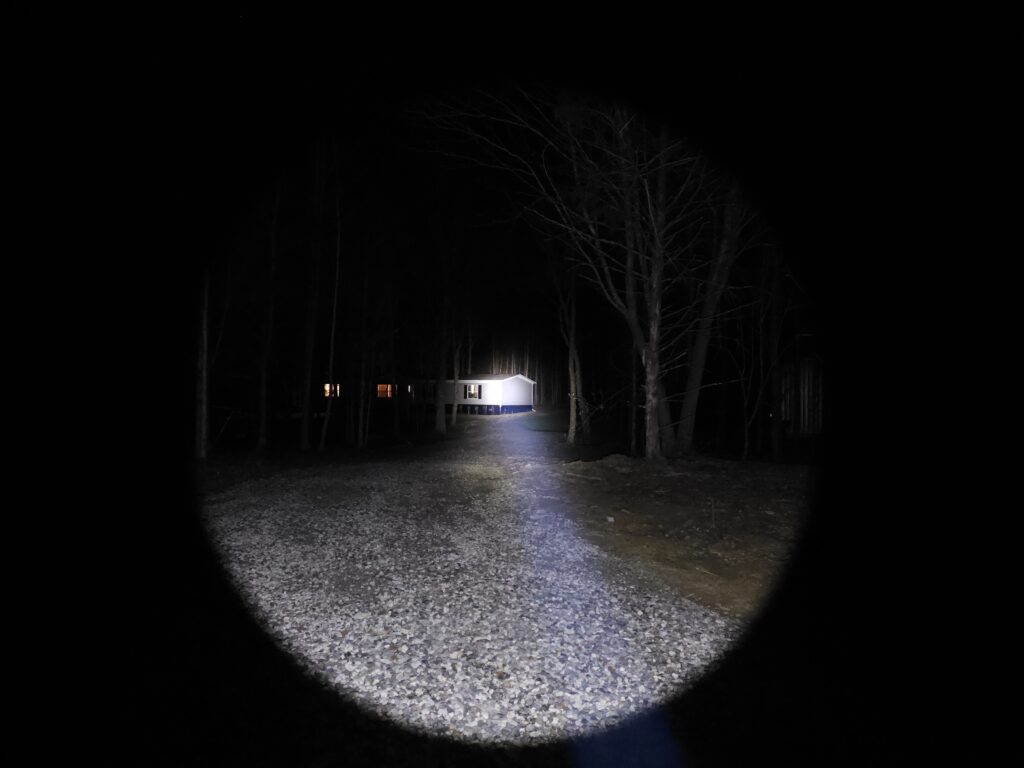
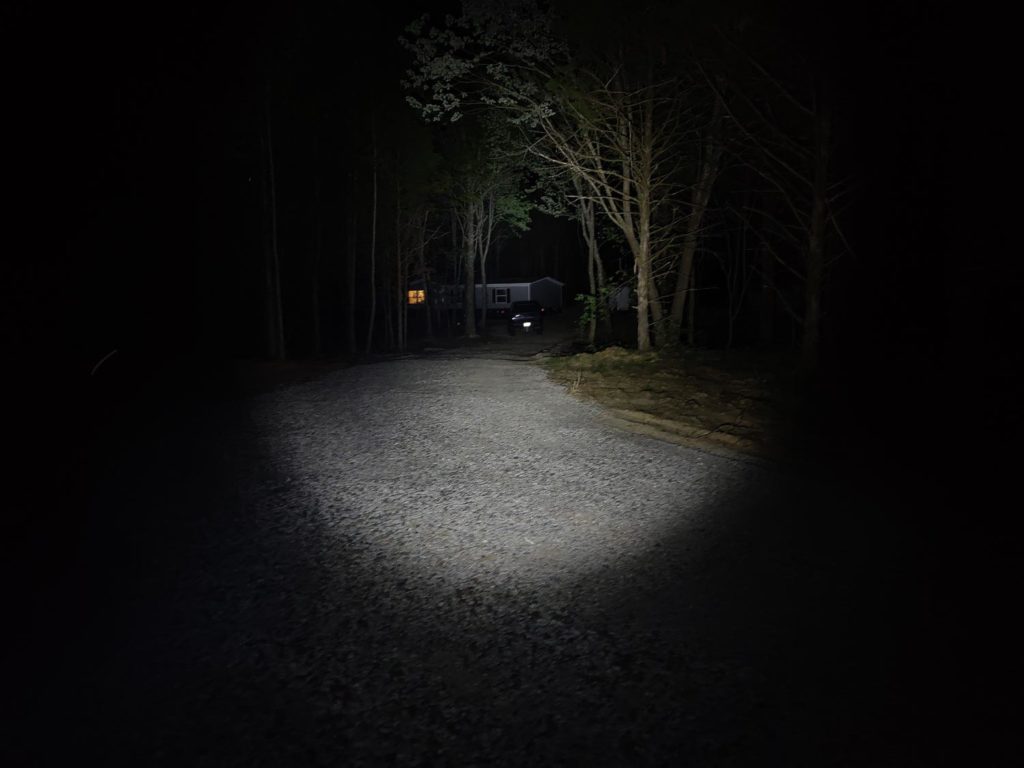

Disclaimer: This flashlight was sent to me for review at no cost by Flashlightbrand. I have not been paid to review, nor have I been holding back on problems or defects.
Final Verdict
Pros
- Finish is very even and
- Use of regular AA cells allows for easy access.
- Incredible throw for the size
- No PWM
Cons
- No onboard charging
- No battery indicator
- HUGE logo on battery tube
- Very greasy o-rings and threads
Explanation on star ratings:
1: Avoid: a match would be a better choice – 2: Poor: significant defect or issues; almost unusable – 3: Average: some defects or issues; but still usable 4: Good: recommended (minor issues) – 5: Great: highly recommended

4.5 stars: ★★★★★⋆
The PK25 is similar in some ways to the Maglite Mini, and in some other ways, it couldn’t be further from it. Don’t pick this up expecting it to be a shot for shot comparison of that. What it is, however, is an advancement in almost every way. More efficient, more powerful, lighter, fantastic fit and finish…. the list goes on. However, while this is a fantastic light, a few key changes to the light would make it a stellar small form-factor thrower. But, in its current guise, it is still near the top of what you can expect to find (Especially for the price!). If I were to change things up a little bit, I prefer rechargeable batteries and this is something that, even though it is done for convenience sake, is kind of a hindrance for someone who has adopted an almost entirely rechargeable lifestyle. If it were to accept (and have a subsequent shorter tube for) a rechargeable 14500 and then extend that slightly for a charging circuit, I think this would be a winner in all regards. At this price point however, the PK25 is stout in performance, and again efficient so it will give you low mode for an incredibly long time.
Oh, and what is up with this gigantic logo?! If this were to go around the circumference of the light near the bezel, it would be far less an eyesore. Again, I can vehemently recommend the PK25, when compared to other recent 2*AA pocket lights, and that recommendation is based on performance. I was teetering on the fence about what to give the PK25, but ultimately settled on 4.5 stars. The performance can’t be beat and while throw may not be my preference, it is hard to argue with numbers.
Buy your Lumintop PK25 here:
Note: August 2023: WARNING: don’t buy from flashlightbrand.com!!!
We received questions whether flashlightbrand.com is still legit, because they either didn’t respond, or didn’t receive their orders. We tried to reach out multiple times, through multiple platforms, and they never replied to any of our messages. Warned: DO NOT BUY FROM FLASHLIGHTBRAND.com, because you will not receive your flashlight
1lumen selects and reviews products personally. We may earn affiliate commissions through our links, which help support our testing.